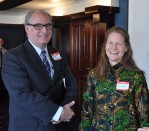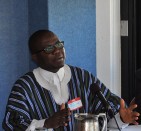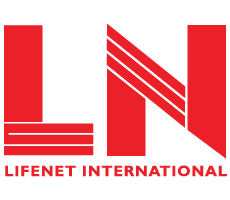
07 Jul Building Effective Partnerships with Faith-Based Organizations
“Thank you… As mentioned, I’m here representing Christian Connections for International Health, and the topic of today’s discussion is very close to our heart. The mission of CCIH is to “promote global health and wholeness from a Christian perspective.” To my knowledge, CCIH is the only organization in the world that seeks to unite all Christian health ministries – international and local – to improve global health and wholeness.
Over the past 30 years, the CCIH network has grown to include hundreds of individual health practitioners and around 200 organizations based both in the U.S. and abroad. Our network is diverse: spanning the Christian spectrum, including secular affiliates as well, ranging from small organizations to large, comprising a community of people from many disciplines and nationalities dedicated to a vision of a world where all without bias have access to basic health and prevention services.

Speaker Garrett Grigsby, Interim Executive Director, CCIH and Jennifer Macias, Deputy Director, HRH and Health Systems Strengthening, IntraHealth International
So, if there’s an overarching theme to what our members care about and work on, it is “strengthening health systems” and, of course, “human resource development” with regard to this. And with this background, I’ll focus on a couple of CCIH members and their work related to today’s topic.
LifeNet International, which operates in East Africa, exists to improve the quality of health systems from the ground up, and is specifically dedicated to health systems strengthening. Through partnerships with church-based health clinics, LifeNet implements practical responses to everyday health challenges facing the poor. It targets church-based clinics because they provide more patients with higher-quality care at lower cost than their counterparts. In this part of the world, churches often operate networks of health centers, as well as educational and religious facilities, making them highly effective in providing healthcare services.
A critical point behind LifeNet’s success is how it all began: with a foundation of research and innovation. After three years of research and testing in Burundi, LifeNet developed its “conversion franchise model.” The model is designed to scale up quickly, and over the past 18 months, has grown from 10 health centers to 51, all the while seeing significant increases in the quality of healthcare delivered.

Panel Member Samuel Nugblega, Technical Adviser on Leadership, Governance and Human Resources for the Christian Health Association of Ghana
LifeNet multiplies systems strengthening efforts by making strategic investments in human resources. The conversion franchise model is designed for impact, scale and sustainability, drawing on business principles to build capacity and generate long-term effect. Every pharmaceutical delivered or piece of equipment distributed is financed by partner clinics themselves, and paired with comprehensive, ongoing training. Progress is tracked using standard monitoring & evaluation techniques, and it has seen a significant increase in the quality of care, and an impressive expansion covering over 10% of its catchment area population.
In addition to a great model, success of its medical and business training is based on trust and relationships. Building meaningful relationships with partner clinics leads to increased capacity and lasting behavior change. Nurse and management trainers provide consistent on-site trainings in local languages with regular follow up and feedback. The model allows health centers to become thriving enterprises that provide quality care and plan for the future by re-investing their own earnings.
And speaking of money – this great work is difficult to accomplish without it. Any discussion about advancing “Human Resources for Health” and “Health Systems Strengthening” by engaging with international donors should include a forthright discussion about the ability of faith-based organizations to access funding. For faith-based organizations, there are sometimes special considerations or challenges.
Another CCIH member, SIL LEAD (language, education and development) was born out of SIL International, which has been around for 80 years, is of considerable size, and has solid relationships with many international organizations (but not funding relationships). SIL International made a strategic decision that it was time to engage in a more concrete and tangible way with these donors. The reason was NOT that SIL needed USAID, DFID or UN funding to continue its activities. Rather, it was because it felt these agencies needed SIL’s expertise, and that more meaningful results could be achieved on a variety of development priorities by working together.
Some fundamental management or structural issues had to be addressed, as the old way of doing business would be a challenge in terms of a typical funder-grantee relationship. Management authority rested on the power of persuasion with staff, and that is not the best fit for engagement with international donors.
Totally reinventing itself specifically to engage with donors did not seem to be the answer. Its management structure had worked well for decades, particularly with its institutional culture and for the purpose of implementing its faith work. A decision was made to create and resource a separate non-profit — SIL LEAD — that would be specifically designed and staffed to pursue funding from international organizations, and carry out projects awarded from these large donors.
SIL LEAD has been cautious about seeking funds directly from USAID choosing to apply only for small, targeted grant opportunities. At the same time, it made a concerted effort to cultivate larger NGOs and contractors that receive funding from USAID, but needed specific, high-level expertise in order to make their projects successful. The results have been impressive, as a number of sub-grants have been awarded. Significantly, success with USAID has attracted private donor support in recognition that SIL LEAD knows what it is doing and will clearly grow and be around for a long while.
To sum up, doing this work takes a lot of strategic thought and preparation. More than that, research, experimentation and innovation. The work is highly relational, likely much more so than it might be in the U.S.
The importance of accessing resources cannot be denied. However, don’t chase money from an international organization simply because you need it, and they have it. Like SIL LEAD, if you can help international donors expand their reach or improve outcomes because of your experience and expertise – and get paid for doing so – that’s great, and that’s the proper approach. Don’t risk losing your identity and becoming beholden to large powerful donors by chasing dollars.
Internal management challenges can make it difficult for faith-based NGOs to engage with large international donors. The question is: is it worth making substantial management changes – and what kinds of changes need to be made? How would these changes impact or even change your mission?
And what should your engagement look like? If engagement means being a grantee of a large international donor, this can be a daunting experience. Why not partner with a more experienced NGO or contractor as opposed to being the prime – at least in the beginning? You can still receive funding; and exert positive influence over programming and policymaking by partnering with other faith-based or even secular groups.
Let me close by addressing the question of the “future for greater collaboration between FBOs and international organizations.” An issue that’s on the minds of CCIH members is how FBOs are used in the Ebola crisis – and one could carry this thought forward beyond the current Ebola situation to other health-related issues.
As the world comes together to turn the tide on Ebola and then repair the damage, strengthening health systems is of paramount importance. Related to this is how to communicate prevention or behavior change information to the masses. It’s literally a life or death proposition, and it’s particularly problematic in certain countries because of longstanding deficiencies in health systems and mistrust of government institutions.
The question is, who can best communicate this vital information? Who in the community is a trusted voice, understands the cultural context, and even speaks the language? And who has a track record of actually getting their audience to change behaviors?
The obvious answer to all of these questions: leaders of local faith-based institutions. If the international donor community wants to have prevention messages accepted and acted upon, and see real behavior change, in my judgment, they need to be working with and through churches, mosques and the whole host of faith-based NGOs.
We’re all aware of the heroic role faith-based NGOs have been playing in this effort. I’m confident they are appreciated, but I want to emphasize this point because the crisis is going to take a long time to turn around, and faith-based NGOs have a significant positive role to play. It’s certainly a huge opportunity for the international donor community to put its money where its mouth is with regard to engagement with faith-based organizations.”
